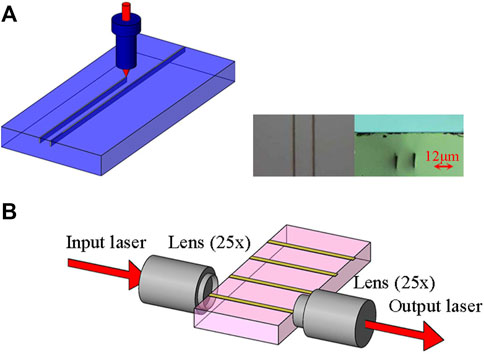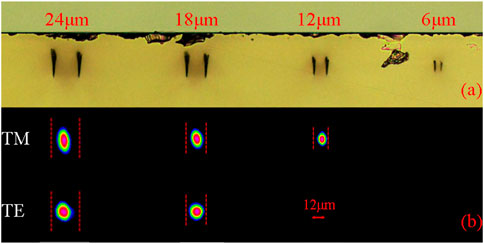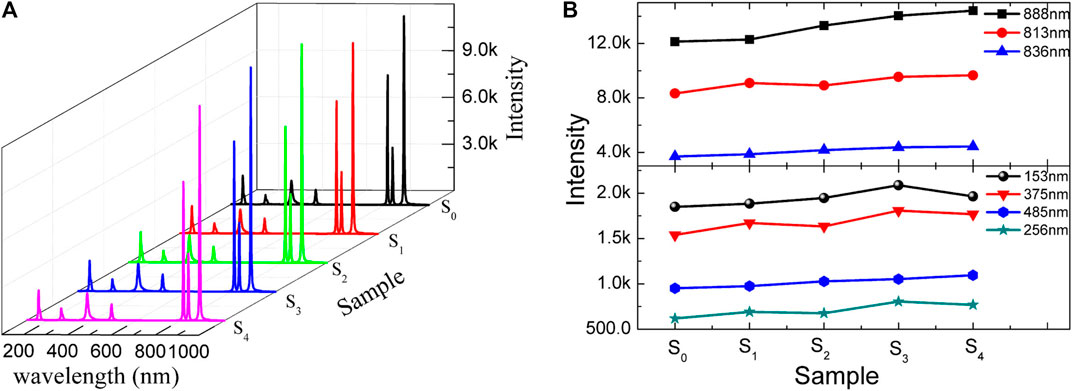- 1School of Electronic and Information Engineering, Qingdao University, Qingdao, China
- 2School of Physics, Qingdao University, Qingdao, China
- 3Institute of Frontier and Interdisciplinary Science and Key Laboratory of Particle Physics and Particle Irradiation (MOE), Shandong University, Qingdao, China
The femtosecond laser writing with double-line technique was employed to fabricate buried channel waveguides with different widths in Yb:YVO4 crystal. Model profiles of the waveguides were captured using the endface coupling setup at the wavelength of 633 nm under TE and TM polarization. Furthermore, the confocal micro-Raman spectra in bulk and waveguide areas were studied at the wavelength of 633 nm. The enhanced Raman intensity were performed in waveguide areas.
Introduction
Yttrium vanadate (YVO4) is isostructural and crystallizes in the tetragonal space group
As a basics component of integrated photonics, optical waveguide structures can confine light propagation within small volumes. The optical properties perform better in waveguide areas in comparison with the substrate. More than one hundred materials are fabricated as optical guiding structures, including single crystals, polycrystalline ceramics, glasses, semiconductors, and organic materials [10–14]. As a fast, flexible, and cost-effective technique, femtosecond laser inscription has been used to fabricate diverse photonic structures on micro- or nano-scales [13]. Femtosecond laser inscription display controlled properties with ultrashort pulse width, extremely high peak intensity and other adequately inscription parameters [13]. So, channel waveguide structure with double lines in Nd:YVO4 crystal was studied by femtosecond laser inscription [15]. As an excellent optical materials, waveguides in Nd:YVO4 crystal have been also fabricated using ion irradiation with proton [16], N [17], Si [18], He [19], O [20] ions and swift Kr ions [21].
The Raman effect was discovered by C.V. Raman in 1928, which can be used to describe the inelastic scattering of photons on a quantized molecular system [22]. As an excellent Raman crystal, the Raman characteristic of YVO4 is reported by experimental and simulated methods [23]. The Raman and infrared active modes of YVO4 crystal were firstly theoretically analyzed and symmetry assigned in Ref. [1]. Nd:YVO4 crystal has been studied using as self-Raman laser material, based on the Raman peak at ∼888 nm in YVO4 host [17].
Although, Nd:YVO4 waveguides have been well studied, the waveguide structure of Yb:YVO4 still need more attentions. Here, channel buried optical waveguides in Yb:YVO4 crystals were fabricated using femtosecond laser inscription with different widths. Due to the birefringence of uniaxial Yb:YVO4 crystal, model profiles in the two-line waveguide structures at 633 nm under TE and TM polarization were investigated. The peaks in confocal micro-Raman spectra were recorded and assigned to the Raman modes in the Yb:YVO4 waveguide areas and substrate.
Experiments
The Yb:YVO4 crystal with dimension 10 (x) × 6 (y) × 4 (z) mm3, was optically polished and applied to produce waveguides along y axis using the double-line technique. A Ti:sapphire amplifier system (Libra, Coherent Inc.) with repetition rate of 1 kHz, maximum pulse energy of 4 mJ, pulse width of 40 fs and central wavelength of 800 nm was used to fabricate the buried channel waveguide structures at the Shanghai Institute of Optics Fine Mechanics, China. A laser beam with a writing speed of 20 μm/s was focused 50 μm below the largest faces in each crystal having a lens with a numerical aperture of 0.55. Figure 1A shows the laser writing setup used in Yb:YVO4 crystals. The details of the samples are shown in Table 1, including laser power and width of two - line varies from 6 to 24 μm with a step of 6 μm.

FIGURE 1. (A) Laser writing setup used in Yb:YVO4 crystals (left); Schematic photographs of the buried channel waveguide structures in Yb:YVO4 crystals (right) cross section and top section; (B) Endface coupling setup at 633 nm.
An endface coupling setup was employed to study the near-field intensity profiles of the Yb:YVO4 crystal waveguides with a He–Ne laser at the wavelength of 633 nm, as shown in Figure 1B. Furthermore, we used two microscope objective lens (× 25) to couple the 633 nm laser light through the waveguide structure. The near-field intensity profiles were then recorded using a charge-coupled device camera. A metallographic microscope using reflected polarized light was applied to catch the images of the waveguides at different magnifications. The Raman spectra of the bulk and centers of waveguide areas in the Yb:YVO4 crystals were recorded with a micro-Raman spectrometer (Horiba/Jobin Yvon HR800) at the wavelength of 633 nm with the laser size of 1 μm at room temperature.
Results and Discussion
In this study, channel waveguide structures were fabricated by laser writing using the double-line technique in Yb:YVO4 crystal, as shown in Table 1. In order to limit the transmission of light, different writing energies were used in fabricating waveguide structures with different widths. Figure 2 contains photographs and model profiles of the buried channel waveguide structures in Yb:YVO4 crystal at the wavelength of 633 nm under TE and TM polarization. The photographs collected using a microscope at cross-section of S1 (6 µm), S2 (12 µm), S3 (18 µm), and S4 (24 µm) were shown in Figure 2A. Many flaws at the junction of the crystal and air originate from optical polishing. Areas between the laser writing two lines can be clearly seen at the endface photographs of S1, S2, S3, and S4, indicating the possible formation of the waveguide structures with refractive index variation. The model profiles of S2 (12 µm), S3 (18 µm), and S4 (24 µm) that were measured at the wavelength of 633 nm under TE and TM polarization were shown in Figure 2B. The dashed lines mean the damage track in S2 (12 µm), S3 (18 µm), and S4 (24 µm). The results show that S1 cannot confine the 633 nm laser light under both TE and TM polarization, while S2 only confines the 633 nm laser light under TM polarization. 12 µm (S2) maybe the lower limit width of mode transmission in Yb:YVO4 crystals at 633 nm. The results may imply that the width of double lines fabricated by laser writing can influence the light guiding.

FIGURE2. (A) Cross-section of the buried channel waveguide structures in Yb:YVO4 crystals; (B) Model profiles of S2, S3, and S4 at 633 nm under TE and TM polarization.
To investigate the effect on the laser writing, the confocal micro-Raman spectra in S0, S1, S2, S3, and S4 were obtained by using a confocal micro-Raman system with an excitation wavelength of 633 nm at room temperature, as shown in Figure 3A, which corresponds to the symmetry species (A1g + B1g) [24]. The spectra were measured vary from 100 to 1,000 cm−1 at the smallest end face of the samples. Raman peak positions were listed in Table 2, where none extra peak and peak shift existence in waveguide areas and Yb:YVO4 substrate comparing with the results in Refs. [16, 17, 23]. The experiment modes vary with different wavelengths.

FIGURE 3. (A) Confocal micro-Raman spectra in Yb:YVO4 crystal and waveguide areas in S0, S1, S2, S3, and S4; (B) Intensity of the confocal micro-Raman peaks in Yb:YVO4 crystal and waveguide areas in S0, S1, S2, S3, and S4.
The Raman spectra can provide information about the phonon modes, from the energy of the laser photons shifted by the interaction of the laser light with phonons or other excitations. As reported in Refs. [25, 26], the Raman peaks corresponds to the internal vibrations into VO43− group and external vibrations of complex VO43− and Y3+ ions in YVO4 unit cell. The symmetric stretch (ν1), symmetric bending (ν2), anti-symmetric stretch (ν3) and anti-symmetric bending (ν4) of the VO4 “molecules” are four distinct internal vibrational modes in VO4 tetrahedron [19, 26, 27]. The peaks at 153, 485, and 813 cm−1 are assigned to B1g mode; the peaks at 375 and 888 cm−1 are to A1g mode; 258 and 836 cm−1 are belongs to the Eg modes [1, 17, 23]. As reported by Zhang et al. [28], the change of peak position in crystal Raman spectrum could disclose the stress and strain in the sample, while the change of full width half maximum (FWHM) indicates crystal quality change. In our work, the peak position and width are both none change, meaning the waveguide areas keep good crystal structures. While one can see that all peak intensities are enhanced in the waveguide areas comparing with the Yb:YVO4 substrate, as shown in Figure 3B. Especially, the enhanced intensity of confocal micro-Raman peaks at 888, 836, and 485 cm−1 were performed with increasing waveguide width in S1, S2, S3, and S4, making the obtained waveguides promising candidates for the development of integrated self-Raman laser sources.
Conclusion
We fabricated buried channel waveguides in Yb:YVO4 crystal using the femtosecond laser writing with double-line technique. The photographs of waveguides structures with the widths of 6, 12, 18, and 24 µm were captured using a metallographic microscope with reflected polarized light. Model profiles at TE and TM polarization were captured using the endface coupling setup at the wavelength of 633 nm. The results imply that the width of two lines fabricated using the laser writing influences the light guiding. The confocal micro-Raman spectra of the bulk and waveguide areas in the Yb:YVO4 crystal were studied at 633 nm. The enhanced Raman intensity at 888, 836, and 485 cm−1 were performed with increasing waveguide width in waveguide areas.
Data Availability Statement
The original contributions presented in the study are included in the article/Supplementary Material, further inquiries can be directed to the corresponding authors.
Author Contributions
TL and WK proposed research ideas and plans, TL and YB performed the experiments and measurements and was responsible for writing the manuscript. HL,YL, FL and LC were responsible for experiments and measurements. All authors contributed to the article and approved the submitted version.
Funding
This work is supported by National Science Foundation of China (Grant No. No.11805108 and 11805142).
Conflict of Interest
The authors declare that the research was conducted in the absence of any commercial or financial relationships that could be construed as a potential conflict of interest.
Publisher’s Note
All claims expressed in this article are solely those of the authors and do not necessarily represent those of their affiliated organizations, or those of the publisher, the editors and the reviewers. Any product that may be evaluated in this article, or claim that may be made by its manufacturer, is not guaranteed or endorsed by the publisher.
References
1. Fuks H, Kaczmarek SM, Macalik L, Macalik B, Hanuza J. EPR and vibrational studies of YVO4:Tm3+, Yb3+ single crystal. Opt Mater (2009) 31:1883–7. doi:10.1016/j.optmat.2008.10.051
2. Zhang N, Wang J, Hu X, Zhang H, Santos C, Ayala A-P, et al. Phonons in isostructural (Nd,Yb):YxGd1-x(VO4) laser crystals: A Raman scattering study. J Solid State Chem (2011) 184:905–10. doi:10.1016/j.jssc.2011.02.018
3. Tian X, Zhou Z, Dai Q, Han W, Liu J, Zhang H. Raman study of oxygen deficient YVO4 single crystals. Laser Phys (2012) 22:688–92. doi:10.1016/0025-5408(95)00126-3
4. Wu S-F, Wang G-F, Xiea J-L. Growth of high quality and large-sized Nd3+:YVO4 single crystal. J Cryst Growth (2004) 266(4):496–9. doi:10.1016/j.jcrysgro.2004.03.007
5. Li G-C, Chao K, Peng H-R, Chen KK-Z. Hydrothermal Synthesis and Characterization of YVO4 and YVO4:Eu3+ Nanobelts and Polyhedral Micron Crystals. J Phys Chem C (2008) 112(16):6228–31. doi:10.1021/jp710451r
6. Zhong D-G, Teng B, Li J-H, Zhang S-M, Zhang B-T, Wang C, et al. Growth and laser action of Yb: YVO4 crystals with low Yb doping concentration. J Cryst Growth (2012) 358:16–9. doi:10.1016/j.jcrysgro.2012.07.029
7. Zhou Y-S, Chen J-X, Zhang Y-X, Xu H-H, Passively mode-locked performances of c-cut Nd:La0.05Lu0.95VO4 crystal. Opt Commun (2021) 498:127235. doi:10.1016/j.optcom.2021.127235
8. Sanson A, Giarola M, Rossi B, Mariotto G, Cazzanelli E, Speghini A. Vibrational dynamics of single-crystal YVO4 studied by polarized micro-Raman spectroscopy and ab initio calculations. Phys Rev B (2012) 86:214305. doi:10.1103/PhysRevB.86.214305
9. Zhang J-C, Wang X-S, Marriott G, Xu C-N. Trap-controlled mechanoluminescent materials. Prog Mater Sci (2019) 103:678–742. doi:10.1016/j.pmatsci.2019.02.001
10. Liu T, Yao Y-C, Liu F-R, Cheng L, Bao Y-F, Kong W-J, et al. Enhanced Raman intensity in ZnS planar and channel waveguide structures via carbon ion implantation. Results Phys (2021) 112:110733. doi:10.1016/j.optmat.2020.110733
11. Zhao J-H, Jiao X-S, Ren Y-Y, Gu J-J, Wang S-M, Bu M-Y, et al. Lithium niobate planar and ridge waveguides fabricated by 3 MeV oxygen ion implantation and precise diamond dicing. Chin Opt Lett (2021) 19:060009. doi:10.3788/COL202119.060009
12. Shen X-L, Zhu Q-F, Zheng R-L, Lv P, Guo H-T, Liu C-X. Near-infrared optical properties of Yb3+-doped silicate glass waveguides prepared by double-energy proton implantation. Results Phys (2018) 8:352–6. doi:10.1016/j.rinp.2017.12.040
13. Zhang B, He S, Yang Q-X, Liu H-L, Wang L, Chen F. Femtosecond laser modification of 6H–SiC crystals for waveguide devices. Appl Phys Lett (2020) 116:11903. doi:10.1063/1.5145025
14. Niu Y-F, Yang L, Guo D-J, Chen F, Li X-Y, Zhao G, et al. Efficient 671 nm red light generation in annealed proton-exchanged periodically poled LiNbO3 waveguides. Chin Opt Lett (2020) 18:111902. doi:10.3788/COL202018.111902
15. Silva W-F, Jacinto C, Benayas A, Vazquez de Aldana J-R, Torchia G-A, Chen F, et al. Femtosecond-laser-written, stress-induced Nd:YVO4 waveguides preserving fluorescence and Raman gain. Opt Lett (2010) 35:916–8. doi:10.1364/OL.35.000916
16. Liu X-H, Zhao J-H, Zhang S-M, Peng B-G, Chen M, Ming X-B, et al. Damage behaviors in Nd:YVO4 by multi-energy proton implantation. Nucl Instrum Meth B (2012) 286:213–7. doi:10.1016/j.nimb.2011.11.015
17. Han Y, Zang Z-G, Qiu F. Swift-heavy ion implanted Nd:YVO4 waveguides with birefringence preservation and Raman gain enhancement. Optik (2017) 140:579–83. doi:10.1016/j.ijleo.2017.04.048
18. Chen F, Wang X-L, Lu Q-M, Fu G, Li S-L, Wang K-M, et al. Property study of Si+-ion-implanted Nd:YVO4 waveguides. Appl Phys B (2002) 75:895–7. doi:10.1007/s00340-002-1057-7
19. Liu X-H, Zhang S-M, Zhao J-H, Chen M, Peng B-G, Qin X-F, et al. Optical properties of a single mode planar waveguide in Nd:YVO4 fabricated by multienergy He ion implantation. Appl Opt (2011) 50:3865–70. doi:10.1364/AO.50.003865
20. Chen F, Wang L, Jiang Y, Wang X-L, Wang K-M, Fu G, et al. Optical channel waveguides in Nd:YVO4 crystal produced by O+ ion implantation. Appl Phys Lett (2006) 88:071123. doi:10.1063/1.2177632
21. Zhang L, Liu P, Liu T, Zhou Y-F, Sun J-R, Wang Z-G, et al. Optical properties of planar waveguide in Nd:YVO4 crystal formed by swift Kr8+ ion irradiation. Nucl Instrum Meth B (2013) 307:459–62. doi:10.1016/j.nimb.2013.02.042
22. Cialla-May D, Schmitt M, Popp J. Theoretical principles of Raman spectroscopy. Phy Rev Mater (2019) 4. doi:10.1515/psr-2017-0040
23. Miller S-A, Caspers H-H, Rast H-E. Lattice Vibrations of Yttrium Vanadate. Phys Rev (1968) 168:964. doi:10.1103/PhysRev.168.964
24. Lu G-W, Li C-X, Wang W-H, Wang Z-H, Xia H-R, Zhao P. Raman investigation of lattice vibration modes and thermal conductivity of Nd-doped zircon-type laser crystals. Mater Sci Eng B-adv (2003) 98:156–60. doi:10.1016/S0921-5107(03)00044-8
25. Kim M, Kang S, Processing effect on the luminescence and raman spectra of Gd1-xVO4:Eux3+ phosphors, J Mater Res (2007) 22 (8):2288 - 96. doi:10.1557/jmr.2007.0290
26. Kolesnikov I-E, Tolstikova D-V, Kurochkin A-V, Platonova N-V, Pulkin S-A, Manshina A-A, et al. Concentration effect on structural and luminescent properties of YVO4: Nd3+ nanophosphors. Mater Res Bull (2015) 70:799–803. doi:10.1016/j.materresbull.2015.06.023
27. Guedes I, Hirano Y, Grimsditch M, Wakabayashi N, Loong C-K, Boatner L-A. Raman study of phonon modes in ErVO4 single crystals. J Appl Phys (2001) 90:1843–6. doi:10.1063/1.1384858
Keywords: Yb:YVO4 crystal, optical waveguide, femtosecond laser inscription, Raman sepectra, optical properties
Citation: Bao Y-F, Liu T, Kong W-J, Luo H-Q, Liu Y, Liu F-R and Cheng L (2021) Enhanced Raman Spectra in Femtosecond Laser Inscribed Yb:YVO4 Channel Waveguides. Front. Phys. 9:758071. doi: 10.3389/fphy.2021.758071
Received: 13 August 2021; Accepted: 13 September 2021;
Published: 23 September 2021.
Edited by:
Hongliang Liu, Nankai University, ChinaReviewed by:
Yufan Zhou, Oak Ridge National Laboratory (DOE), United StatesXiuhong Liu, Hebei University of Engineering, China
Copyright © 2021 Bao, Liu, Kong, Luo, Liu, Liu and Cheng. This is an open-access article distributed under the terms of the Creative Commons Attribution License (CC BY). The use, distribution or reproduction in other forums is permitted, provided the original author(s) and the copyright owner(s) are credited and that the original publication in this journal is cited, in accordance with accepted academic practice. No use, distribution or reproduction is permitted which does not comply with these terms.
*Correspondence: Tao Liu, bGl1dHBoeUAxNjMuY29t; Wei-Jin Kong, a3dqc2RAMTYzLmNvbQ==
†These authors have contributed equally to this work
 Yi-Fei Bao1†
Yi-Fei Bao1† Tao Liu
Tao Liu
